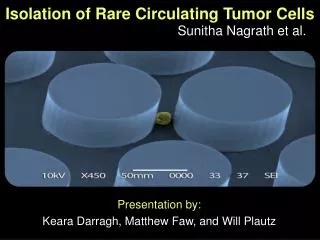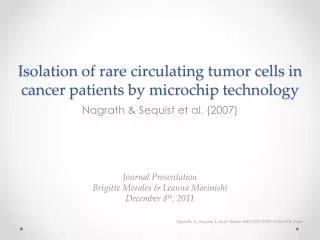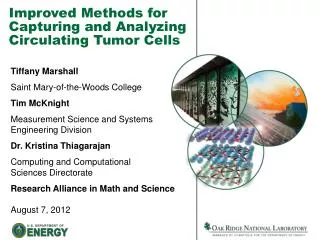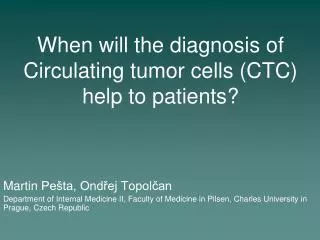
Circulating Tumor Cells (CTCs). - Detection and isolation technologies. Circulating Tumor Cells.

andie + Follow
Download PresentationAn Image/Link below is provided (as is) to download presentation Download Policy: Content on the Website is provided to you AS IS for your information and personal use and may not be sold / licensed / shared on other websites without getting consent from its author. Content is provided to you AS IS for your information and personal use only. Download presentation by click this link. While downloading, if for some reason you are not able to download a presentation, the publisher may have deleted the file from their server. During download, if you can't get a presentation, the file might be deleted by the publisher.

Kyle Rafferty Biomedical Engineering. Capturing Circulating Tumor cells using Nanotechnology . Overview. What are CTC’s? Why is detection important? Older methods of detection Immunomagnetic beads Flat silicon substrates New Advancement Silicon nanopillar substrate Sources. CTC’s.
371 views • 10 slides

No financial disclosure. . Case scenario. 65 y/o man with newly diagnosed pancreatic head adenocarcinomaLocalized by CT scanWhipple procedureSurgical margin and lymph nodes (13) were negativeAdjuvant gemcitabine-based chemoradiationRelapsed in liver 1 year later. Metastasis accounts for 90%
701 views • 37 slides

This is the latest and most up-to-date Market Report from Select Biosciences addressing the CTC and CSCmarkets as they are evolving. In this report, we focus upon technical and business trends in these spaces as they are fast evolving. CTCs have been shown to have prognostic value in a number of cancer types and therefore there is extensive research and development activity to develop methodologies for CTC enumeration as well as analysis. Furthermore, there is a lot of clinical trial activity in a number of different cancer classes seeking to establish the clinical utility of CTC measurements in various cancer subtypes.
254 views • 5 slides

Manifestation of Novel Social Challenges of the European Union in the Teaching Material of Medical Biotechnology Master’s P rogrammes at the University of Pécs and at the University of Debrecen Identification number : TÁMOP-4.1.2-08/1/A-2009-0011.
351 views • 18 slides

Circulating tumor cells (CTCs) in blood of breast cancer patients: Cytological detection and technical characterization. Enrica Bresaola, Mara Jo Miller, Marco Picozzi, Maria Teresa Sandri, Chiara Casadio ______________________ Cytology Unit, Department of Pathology & Laboratory Medicine
102 views • 9 slides

Isolation of Rare Circulating Tumor Cells. Sunitha Nagrath et al. Presentation by: Keara Darragh , Matthew Faw , and Will Plautz. http://www.nibib.nih.gov/news-events/newsroom/circulating-tumor-cells-captured-last. Overview of Metastasis and CTCs. Circulating tumor cells (CTCs)
540 views • 13 slides

Isolation of rare circulating tumor cells in cancer patients by microchip technology. Journal Presentation Brigitte Morales & Leanna Morinishi December 8 th , 2011. Nagrath & Sequist et al. (2007). Nagrath , S., Sequist , L. et al. Nature 450.7173 (2007):1235-239. Print.
512 views • 13 slides

Improved Methods for Capturing and Analyzing Circulating Tumor Cells . Tiffany Marshall Saint Mary-of-the-Woods College Tim McKnight Measurement Science and Systems Engineering Division Dr. Kristina Thiagarajan Computing and Computational Sciences Directorate
399 views • 20 slides

“Isolation of rare circulating tumour cells in cancer patients by microchip technology”. Nagrath et al. Nature 2007 Peter Bojo. Big Picture. Potential uses of CTCs Choice of therapy Monitoring of therapy Explaining the biology of metastasis Microchip is one of many CTC technologies
268 views • 7 slides

’Tumor, Stem cells and Tumor Stem Cells’ Barbara Wollenberg. Universitätsklinikum Schleswig-Holstein, Campus Lübeck Germany. Stochastic Model. Hierarchic Model. Differentiated Tumor cell. Tumor Precursor cell. Tumor-initiating cell. UK-SH - ENT Lübeck. Theories of Tumor Development.
387 views • 17 slides

When will the diagnosis of Circulating tumor cells (CTC) help to patients?. M artin Pešta, O ndřej Topolčan Department of Internal Medicine II, Faculty of Medicine in Pilsen, Charles University in Prague, Czech Republic. What we know today.
516 views • 21 slides

Supplemental figure 1. A. B. + NK cells (1:1 ratio). - NK cells. ATC tumor cells. Atoxic goiter. Fibroblast cell line. 7AAD. C. Autologous B cells. Autologous T cells. Annexin V.
148 views • 1 slides

Second-generation device more effective in capturing circulating tumor cells.
123 views • 1 slides

Describes the importance of liquid biopsy and circulating tumor cells enumeration as a marker of predictive and prognostic value in cancer treatment
1.24k views • 15 slides

Before making any investment in the global Dye Sensitized Solar Cells Dssc market, a clear understanding of the market behavior is necessary. The research study delivers an exhaustive study of the global Dye Sensitized Solar Cells Dssc market. The present market scenario of the industry along with its future prospects are presented in the report. Furthermore, the report delivers keen insights into the global Dye Sensitized Solar Cells Dssc market. A summary of key statistics of the market with the overall status of the manufacturers is presented in this study. The report will be a valuable source of guidance and direction for SMBs, MNCs, a
210 views • 6 slides

Circulating tumor cells (CTCs) are specialized rare cells, which have been shed from a primary solid tumor of the body and circulate in the vasculature system of the body, eventually causing metastasis.
235 views • 3 slides

CTC technology is enabling recovery and analysis of separated cancer cells and CSC is increasing chances of surviving cancer by using nano technology and this factors are fuelling the growth of CTC and CSC industry
251 views • 7 slides

Circulating Tumor Cells Market Analysis, By Technology, By Application (Colorectal Cancer, Breast Cancer, Prostate Cancer), And Segment Forecast From 2012 To 2020
183 views • 4 slides

Circulating tumor cells (CTCs) are cells which detach from its primary or secondary tumors, enters in to the bloodstream and travel to distant organs. This is the evolving field of medical science which are tremendously used in cases of cancer research.
152 views • 11 slides
 Forecast to 2025" width="320px" />
Forecast to 2025" width="320px" />
Circulating Tumor Cells (CTC) Market Size, Share & Trends Analysis Report By By Technology (Detection, Enrichment), Application (Cancer Stem Cell Research, EMT Biomarkers Development), And Segment Forecasts, 2019 - 2025
151 views • 14 slides

Towards a fast, efficient assay for isolating circulating tumor cells. July 30, 2009. PI: Professor David Eddington Grad Student: Cari Launiere Me: Joey Labuz. Introduction. Breast, colon, prostate, and lung cancers accounted for nearly half of cancer deaths (American Cancer Society, 2008)
197 views • 18 slides

The growth of circulating tumor cells (CTC) market is influenced by increasing mortality rate due to cancer, several types of genetic disorders, drastic change in lifestyle, increase in smoking-causing disorders, and rise in consumption of alcohol.